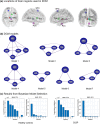Altered habenular connectivity in chronic low back pain: An fMRI and machine learning study
- PMID: 37306031
- PMCID: PMC10318213
- DOI: 10.1002/hbm.26389
Altered habenular connectivity in chronic low back pain: An fMRI and machine learning study
Abstract
The habenula has been implicated in the pathogenesis of pain and analgesia, while evidence concerning its function in chronic low back pain (cLBP) is sparse. This study aims to investigate the resting-state functional connectivity (rsFC) and effective connectivity of the habenula in 52 patients with cLBP and 52 healthy controls (HCs) and assess the feasibility of distinguishing cLBP from HCs based on connectivity by machine learning methods. Our results indicated significantly enhanced rsFC of the habenula-left superior frontal cortex (SFC), habenula-right thalamus, and habenula-bilateral insular pathways as well as decreased rsFC of the habenula-pons pathway in cLBP patients compared to HCs. Dynamic causal modelling revealed significantly enhanced effective connectivity from the right thalamus to right habenula in cLBP patients compared with HCs. RsFC of the habenula-SFC was positively correlated with pain intensities and Hamilton Depression scores in the cLBP group. RsFC of the habenula-right insula was negatively correlated with pain duration in the cLBP group. Additionally, the combination of the rsFC of the habenula-SFC, habenula-thalamus, and habenula-pons pathways could reliably distinguish cLBP patients from HCs with an accuracy of 75.9% by support vector machine, which was validated in an independent cohort (N = 68, accuracy = 68.8%, p = .001). Linear regression and random forest could also distinguish cLBP and HCs in the independent cohort (accuracy = 73.9 and 55.9%, respectively). Overall, these findings provide evidence that cLBP may be associated with abnormal rsFC and effective connectivity of the habenula, and highlight the promise of machine learning in chronic pain discrimination.
Keywords: chronic low back pain; dynamic causal modelling; habenula; resting-state functional connectivity; support vector machine.
© 2023 The Authors. Human Brain Mapping published by Wiley Periodicals LLC.
Conflict of interest statement
The authors declare no conflict of interest.
Figures






Similar articles
-
Disrupted Resting-State Functional Connectivity and Effective Connectivity of the Nucleus Accumbens in Chronic Low Back Pain: A Cross-Sectional Study.J Pain Res. 2024 Jun 17;17:2133-2146. doi: 10.2147/JPR.S455239. eCollection 2024. J Pain Res. 2024. PMID: 38915479 Free PMC article.
-
Altered resting-state functional connectivity and effective connectivity of the habenula in irritable bowel syndrome: A cross-sectional and machine learning study.Hum Brain Mapp. 2020 Sep;41(13):3655-3666. doi: 10.1002/hbm.25038. Epub 2020 Jun 3. Hum Brain Mapp. 2020. PMID: 32488929 Free PMC article.
-
Visual network alterations in brain functional connectivity in chronic low back pain: A resting state functional connectivity and machine learning study.Neuroimage Clin. 2019;22:101775. doi: 10.1016/j.nicl.2019.101775. Epub 2019 Mar 14. Neuroimage Clin. 2019. PMID: 30927604 Free PMC article.
-
Gray Matter Abnormalities in Patients with Chronic Low Back Pain: A Systematic Review and Meta-Analysis of Voxel-Based Morphometry Studies.World Neurosurg. 2024 Apr;184:e397-e407. doi: 10.1016/j.wneu.2024.01.138. Epub 2024 Feb 1. World Neurosurg. 2024. PMID: 38307195
-
The Relationship Between Structural and Functional Brain Changes and Altered Emotion and Cognition in Chronic Low Back Pain Brain Changes: A Systematic Review of MRI and fMRI Studies.Clin J Pain. 2018 Mar;34(3):237-261. doi: 10.1097/AJP.0000000000000534. Clin J Pain. 2018. PMID: 28719509
Cited by
-
The hierarchical organization of the precuneus captured by functional gradients.Brain Struct Funct. 2023 Jul;228(6):1561-1572. doi: 10.1007/s00429-023-02672-5. Epub 2023 Jun 28. Brain Struct Funct. 2023. PMID: 37378854 Free PMC article.
-
Dynamics of Lateral Habenula-Ventral Tegmental Area Microcircuit on Pain-Related Cognitive Dysfunctions.Neurol Int. 2023 Oct 27;15(4):1303-1319. doi: 10.3390/neurolint15040082. Neurol Int. 2023. PMID: 37987455 Free PMC article. Review.
-
The habenula in mood disorders: A systematic review of human studies.Mol Psychiatry. 2025 Aug 1. doi: 10.1038/s41380-025-03105-x. Online ahead of print. Mol Psychiatry. 2025. PMID: 40750674
-
Disrupted Resting-State Functional Connectivity and Effective Connectivity of the Nucleus Accumbens in Chronic Low Back Pain: A Cross-Sectional Study.J Pain Res. 2024 Jun 17;17:2133-2146. doi: 10.2147/JPR.S455239. eCollection 2024. J Pain Res. 2024. PMID: 38915479 Free PMC article.
References
-
- Antunes, G. F. , Pinheiro Campos, A. C. , de Assis, D. V. , Gouveia, F. V. , de Jesus Seno, M. D. , Pagano, R. L. , & Ruiz Martinez, R. C. (2022). Habenula activation patterns in a preclinical model of neuropathic pain accompanied by depressive‐like behaviour. PLoS One, 17(7), e0271295. 10.1371/journal.pone.0271295 - DOI - PMC - PubMed
Publication types
MeSH terms
LinkOut - more resources
Full Text Sources
Medical

